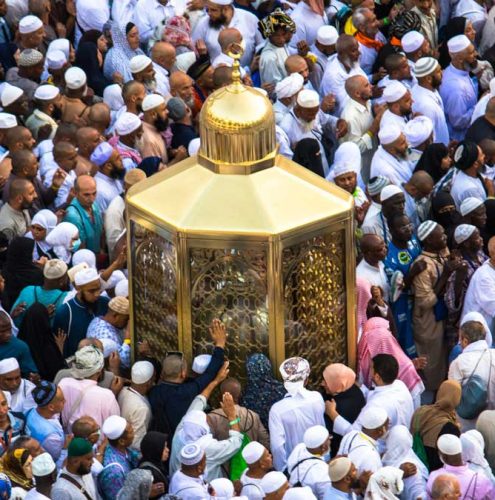Embarking on the sacred journey of Umrah is a deeply personal and spiritually significant experience for Muslims worldwide. Unlike Hajj, which occurs annually during specific dates, Umrah offers the flexibility of being performed throughout most of the year. This flexibility, however, brings forth a crucial question for many aspiring pilgrims: when is the best time to perform Umrah? The answer isn’t always straightforward, as the ideal time depends heavily on individual priorities, balancing factors like weather, crowd levels, budget, and personal spiritual goals.
At Aqsa Hajj, we understand that careful planning is key to a fulfilling pilgrimage. This comprehensive guide will help you navigate the various considerations involved in choosing the optimal time for your Umrah journey. We will explore the pros and cons of different seasons, delve into crowd dynamics, examine cost variations, and discuss the unique significance of performing Umrah during Ramadan, ensuring you have the information needed for effective Umrah booking and planning.
Why Does Timing Matter for Your Umrah Experience?
Choosing the right time for your Umrah can significantly impact your overall experience. Weather conditions can affect your physical comfort during rituals that involve walking and outdoor activities. Crowd levels influence the ease with which you can perform Tawaf (circumambulation around the Kaaba) and Sa’i (walking between Safa and Marwah), as well as your ability to find moments of quiet reflection. Furthermore, the Umrah cost for flights and accommodation can fluctuate dramatically depending on the season, impacting your budget. Understanding these factors allows you to select a period that aligns best with your personal needs and enhances your spiritual connection during this blessed journey.
A Seasonal Breakdown: Pros and Cons for Umrah Pilgrims
Saudi Arabia experiences distinct seasons, each offering a different Umrah experience:
Winter (December to February)
Many consider winter the best time for Umrah regarding weather. Daytime temperatures in Makkah and Madinah are generally pleasant and mild, making outdoor rituals more comfortable. Nights can be cool, requiring warmer clothing.
- Pros: Comfortable weather, moderate crowd levels compared to peak Ramadan season, potentially good availability for Umrah booking if planned in advance.
- Cons: Can still be relatively busy due to favorable weather and coinciding with winter holidays in some countries. Costs might be higher than the absolute off-peak summer months.
Spring (March to May)
Spring offers a transition period. Early spring retains pleasant weather, but temperatures begin to rise significantly towards May. This season often overlaps with school holidays and potentially Ramadan, impacting crowds and costs.
- Pros: Initially comfortable weather, potential for experiencing the unique spiritual atmosphere if it coincides with Ramadan (see below).
- Cons: Rising temperatures towards the end of the season, potentially large crowds if overlapping with holidays or Ramadan, variable Umrah cost.
Summer (June to August/September)
Summer in Saudi Arabia is characterized by extreme heat, with temperatures often soaring above 40°C (104°F). This period sees the lowest number of pilgrims.
- Pros: Least crowded time, offering a quieter experience at the holy sites. Lowest Umrah cost with significant discounts on flights and hotels often available. Excellent availability for Umrah booking.
- Cons: Intense heat can be physically demanding and potentially risky, especially for the elderly, children, or those with health conditions. Requires careful planning for hydration and avoiding peak sun hours.
Autumn (October to November)
Autumn marks another transition, with temperatures gradually becoming milder after the summer heat. Humidity can be a factor. This period follows the Hajj season, often resulting in fewer crowds initially.
- Pros: More comfortable weather than summer, fewer crowds compared to winter or Ramadan, potentially lower Umrah cost than peak seasons, good time for Umrah booking post-Hajj.
- Cons: Weather can be variable, humidity might be uncomfortable for some.
The Ramadan Factor: A Time of Immense Blessings
Performing Umrah during the holy month of Ramadan holds exceptional spiritual significance for Muslims. The Prophet Muhammad (PBUH) stated that Umrah in Ramadan is equivalent in reward to performing Hajj with him. The atmosphere in Makkah and Madinah during Ramadan is unparalleled, filled with devotion, communal prayers (Taraweeh), and shared Iftars.
- Pros: Immense spiritual rewards, unique atmosphere of devotion and community, opportunity to experience fasting and night prayers in the holy cities.
- Cons: Peak season with the largest crowds, significantly higher Umrah cost for flights and accommodation, requires careful Umrah booking far in advance, physically demanding due to fasting combined with rituals.
If choosing Ramadan, consider the first 20 days, which are generally slightly less crowded than the last ten nights, although still very busy.
Navigating the Crowds: Finding Quieter Moments
Crowd levels are a major consideration for many pilgrims. While peak seasons like Ramadan and school holidays are busiest, certain periods offer a more tranquil experience:
- Off-Peak Months: Generally, the months immediately following Hajj (Muharram and Safar) and the summer months (June-September) see the fewest pilgrims.
- Shoulder Seasons: Late autumn (November) and early winter (December, outside of holiday peaks) can offer a good balance of pleasant weather and moderate crowds.
- Timing Within the Day: Even during busy seasons, certain times are less crowded for performing rituals. Many sources suggest performing Tawaf and Sa’i after Fajr prayer (as many return to hotels) or late at night (e.g., 11:00 PM – 2:00 AM) for a more peaceful experience. Performing rituals between Zuhr and Asr prayers might also be less crowded, though hotter.
- Least Crowded Days: According to Saudi authorities, Sunday, Tuesday, and Wednesday tend to be less crowded than weekends (Thursday/Friday).
Understanding Umrah Costs: Budgeting Your Pilgrimage
The Umrah cost varies significantly throughout the year. Key factors influencing price include:
- Season: Ramadan and peak holiday periods command the highest prices. Summer months offer the lowest costs.
- Proximity to Haram: Hotels closer to Masjid al-Haram in Makkah and Masjid an-Nabawi in Madinah are more expensive.
- Booking Time: Booking flights and accommodation well in advance, especially for peak seasons, is crucial. Last-minute Umrah booking is usually more expensive.
- Package vs. DIY: While DIY Umrah can offer savings, well-negotiated packages during off-peak times can also be cost-effective.
Cheapest Times: Generally, the summer months (June-September) and the period immediately after Hajj (Muharram/Safar) offer the most budget-friendly options.
Making Your Choice: What’s the Best Time for You?
Ultimately, the best time for Umrah depends on your personal priorities:
- For Spiritual Rewards: Ramadan is unparalleled, despite the crowds and cost.
- For Comfortable Weather: Winter (December-February) offers the most pleasant climate.
- For Lowest Costs & Fewest Crowds: Summer (June-September) is the most budget-friendly and quietest, if you can manage the heat.
- For a Balance: Consider the shoulder seasons like late autumn (November) or early spring (March, avoiding holidays) for a mix of reasonable weather, moderate crowds, and manageable costs.
- For Families: Winter or cooler spring months might be best, avoiding the extreme summer heat and the intense crowds of Ramadan.
Consider your health, budget, tolerance for crowds, and spiritual goals when making your decision and proceeding with your Umrah booking.
Conclusion: Plan with Purpose and Intention
Choosing when to perform Umrah is an important decision that shapes your pilgrimage experience. By understanding the interplay of seasons, weather, crowd levels, and costs, you can select a time that aligns with your personal circumstances and spiritual aspirations. Whether you seek the heightened spirituality of Ramadan, the comfortable climate of winter, or the quiet solitude of the off-peak season, planning ahead is essential.
Remember, the most crucial element of Umrah is your intention (niyyah) and the sincerity of your devotion. Regardless of when you travel, approach your journey with a prepared heart and a focus on connecting with Allah.
At Aqsa Hajj, we offer a range of Umrah packages throughout the year and can assist with your Umrah booking needs, helping you find the perfect time for your blessed journey. May Allah accept your pilgrimage and grant you a spiritually uplifting experience.
Ready to plan your Umrah? Explore package options or contact Aqsa Hajj today to discuss the best time for your pilgrimage based on your needs. Visit aqsahajj.com for more details.

